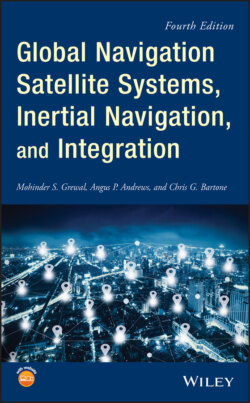Читать книгу Global Navigation Satellite Systems, Inertial Navigation, and Integration - Mohinder S. Grewal - Страница 66
2.4.3 Receiver Computation of UTC
ОглавлениеThe parameters needed to calculate UTC from GPS time are found in subframe 4 of the navigation data message. These data include a notice to the user regarding the scheduled future or recent past (relative to the navigation message upload) value of the delta time due to leap seconds ΔtLFS, together with the week number WNLFS and the day number DN, at the end of which the leap second becomes effective. The latter two quantities are known as the effectivity time of the leap second. “Day one” is defined as the first day relative to the end/start of a week, and the WNLFS value consists of the eight least significant bits (LSBs) of the full week number.
Three different UTC/GPS time relationships exist, depending on the relationship of the effectivity time to the user's current GPS time:
1 First case. Whenever the effectivity time indicated by the WNLFS and WN values is not in the past relative to the user's present GPS time, and the user's present time does not fall in the time span starting at DN + 3/4 and ending at DN + 5/4, the UTC time is calculated aswhere tUTC is in seconds; 86 400 is the number of seconds per day; andwhere 604 800 is the number of seconds per week andtE=user GPS time from start of week (seconds)ΔTLS=delta time due to leap secondsA0=a constant polynomial term from the ephemeris messageA1=a first‐order polynomial term from the ephemeris messaget0t=reference time for UTC dateWN=current week number derived from subframe 1WNt=UTC reference week numberThe user GPS time tE is in seconds relative to the end/start of the week, and the reference time t0t for UTC data is referenced to the start of that week, whose number WNt is given in word 8 of page 18 in subframe 4. The WNt value consists of the eight LSBs of the full week number. Thus, the user must account for the truncated nature of this parameter as well as truncation of WN, WNt, and WNLFS due to the rollover of the full week number. These parameters are managed by the GPS control segment so that the absolute value of the difference between the untruncated WN and WNt values does not exceed 127.
2 Second case. Whenever the user's current GPS time falls within the time span from DN +3/4 to DN +5/4, proper accommodation of the leap second event with a possible week number transition is provided by the following expression for UTC:whereand the definition of ΔtUTC given previously applies throughout the transition period.
3 Third case. Whenever the effectivity time of the leap second event, as indicated by the WNLFS and DN values, is in the past relative to the user's current GPS time, the expression given for tUTC in the first case earlier is valid except that the value of ΔtLFS is used instead of ΔtLS. The GPS control segment coordinates the update of UTC parameters at a future upload in order to maintain a proper continuity of the tUTC timescale.
